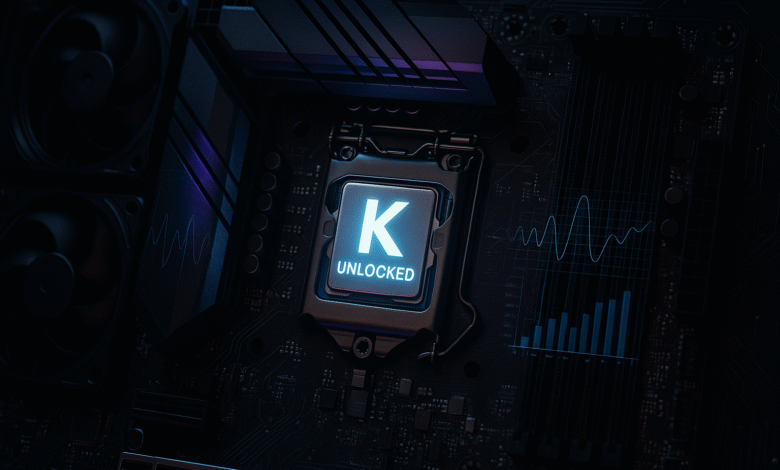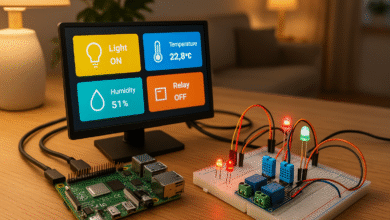
Getting more performance from your computer without spending money sounds too good to be true, but CPU overclocking makes it possible. If you’ve invested in an unlocked CPU like an Intel K-series processor or an AMD Ryzen chip, you’re sitting on untapped potential that can boost your gaming frame rates, speed up video rendering, and improve overall system responsiveness.
Overclocking a CPU means pushing your processor to run faster than its factory settings by increasing the clock speed and adjusting voltage parameters. In 2025, the process has become more accessible than ever, with modern processors featuring built-in safety mechanisms and user-friendly software tools. However, approaching it recklessly can lead to system instability, overheating, or even hardware damage.
This comprehensive guide walks you through everything you need to know about safe CPU overclocking. Whether you’re running an Intel Core i9-14900K or an AMD Ryzen 9 9950X, you’ll learn the proper techniques to overclock your processor while maintaining stability and keeping temperatures under control. We’ll cover the essential tools, step-by-step procedures, and critical safety measures that separate successful overclockers from those who end up troubleshooting crashes.
Understanding CPU Overclocking Basics
What Is CPU Overclocking?
CPU overclocking is the process of increasing your processor’s operating frequency beyond its default specifications. Your CPU’s speed is determined by multiplying the base clock (BCLK) by a multiplier. For example, a 100 MHz base clock with a 40x multiplier produces a 4.0 GHz clock speed.
When you overclock a CPU, you’re essentially instructing it to perform more calculations per second. This translates to improved performance in processor-intensive tasks like gaming, 3D rendering, video editing, and complex computations. Modern CPUs already boost themselves automatically, but manual overclocking can push performance even further.
Benefits of Overclocking Your CPU
The advantages of successful CPU overclocking include:
- Increased performance without hardware upgrades
- Higher frame rates in CPU-bound games
- Faster rendering and encoding times
- Extended lifespan of older systems
- Cost-effective performance boost
- Learning experience about computer hardware
According to recent benchmarks, a well-executed overclock can yield 10-20% performance improvements, which is significant when you consider the zero dollar cost.
Risks and Considerations
Before you start, understand the potential downsides:
- Increased heat generation requiring better cooling
- Higher power consumption and electricity costs
- Potential reduction in CPU lifespan if pushed too hard
- System instability and crashes if done incorrectly
- Possible warranty void on certain components
- Time investment for testing and fine-tuning
Modern processors from Intel and AMD include thermal throttling and other protective measures, so catastrophic failure is rare if you approach overclocking methodically.
Prerequisites for Safe CPU Overclocking
Compatible Hardware Requirements
Not all processors can be overclocked. Here’s what you need:
For Intel Systems:
- K-series processors (Core i5-14600K, i7-14700K, i9-14900K)
- X-series processors (Core i9-10980XE)
- Z-series motherboard (Z790, Z690, Z590)
- KF or KS suffix models also support overclocking
For AMD Systems:
- All modern Ryzen processors support overclocking
- Ryzen 5, 7, and 9 series with X or X3D suffix
- B-series or X-series motherboard (B650, X670, X870)
- Note: First-gen Ryzen 7 5800X3D has limitations
You’ll also need adequate cooling and a quality power supply unit (PSU) capable of handling increased power draw.
Essential Cooling Solutions
Effective cooling is non-negotiable for safe overclocking. Stock coolers won’t cut it for serious overclocks. Consider these options:
- Tower air coolers like Noctua NH-D15 or be quiet! Dark Rock Pro 4
- All-in-one (AIO) liquid coolers with 240mm or larger radiators
- Custom water cooling for extreme overclocking
- Quality thermal paste application
Your CPU cooler must handle the increased thermal load. Target temperatures below 80°C under full load for daily use overclocks.
Required Software Tools
Download these essential programs before starting:
Monitoring Software:
- HWMonitor or HWiNFO for temperature tracking
- Core Temp for real-time CPU monitoring
- CPU-Z for frequency verification
Benchmarking Tools:
- Cinebench R23 for rendering performance
- 3DMark for gaming benchmarks
- Geekbench for multi-platform comparisons
Stress Testing Software:
- Prime95 for maximum stability testing
- AIDA64 for comprehensive system stress
- OCCT for thorough stability verification
- Intel Burn Test for quick stability checks
Overclocking Utilities:
- Intel Extreme Tuning Utility (Intel XTU) for Intel processors
- AMD Ryzen Master for AMD systems
- Your motherboard’s BIOS/UEFI interface
Step-by-Step CPU Overclocking Guide
Step 1: Establish Your Baseline
Before making any changes, document your system’s current performance and temperatures:
- Run a benchmark like Cinebench and record the score
- Monitor maximum temperatures during the benchmark
- Note your current CPU voltage (Vcore) under load
- Check power consumption at stock settings
- Run a 30-minute stress test to ensure stock stability
Write these numbers down. They’re your reference points for measuring improvement and identifying problems.
Step 2: Update Your BIOS
Before overclocking, update your motherboard BIOS to the latest version. Manufacturers regularly release updates that improve stability, fix bugs, and enhance overclocking capabilities. Download the update from your motherboard manufacturer’s website and follow their installation instructions.
Step 3: Adjust CPU Multiplier Settings
The simplest overclocking method involves adjusting the CPU multiplier:
Using Intel XTU:
- Open Intel XTU and switch to the Basic Tuning tab
- Disable any automatic overclocking features
- Increase the CPU multiplier by one step (e.g., 40x to 41x)
- Apply settings and stress test for 30 minutes
- Monitor temperatures staying below 80°C
Using AMD Ryzen Master:
- Launch Ryzen Master and select Manual mode
- Switch Control Mode from Default to Manual
- Adjust the CPU Clock Speed slider upward by 50-100 MHz
- Apply changes and test stability
- Check temperatures during stress testing
Using BIOS:
- Enter BIOS by pressing Delete or F2 during boot
- Navigate to Overclocking or AI Tweaker section
- Locate CPU multiplier or CPU ratio settings
- Increase by one step
- Save and exit, then boot to Windows for testing
Step 4: Incremental Testing Process
The key to safe CPU overclocking is patience. Follow this loop:
- Increase multiplier by one step
- Boot into Windows
- Run benchmarking software
- If stable, run stress test for 30 minutes
- Monitor temperatures and watch for crashes
- If successful, increase multiplier again
- Repeat until you hit instability or thermal limits
When you encounter crashes or temperatures exceeding 85°C, you’ve found your limit. Back down one step for your stable overclock.
Step 5: Voltage Adjustment
If you hit a stability wall before reaching thermal limits, you may need to increase core voltage:
- Return to BIOS or overclocking utility
- Locate CPU voltage or Vcore settings
- Increase voltage by small increments (0.025V)
- Never exceed your CPU’s maximum safe voltage (research your specific model)
- Test stability after each voltage increase
- Higher voltage generates more heat
For most modern processors, staying under 1.35V for daily use is recommended. Intel K-series chips typically handle 1.30-1.35V safely, while AMD Ryzen processors vary by generation.
Step 6: Extended Stability Testing
Once you find settings that seem stable, run extended tests:
- Prime95 for 2-4 hours minimum
- AIDA64 stress test overnight
- OCCT for comprehensive system validation
- Real-world usage for several days
If your system passes these tests without crashes or thermal throttling, you’ve achieved a stable overclock.
Also Read: CPU vs GPU: Which is Better for Gaming
Advanced Overclocking Techniques
Per-Core Overclocking
Modern CPUs have varying quality cores. You can optimize performance by overclocking each core individually:
- Use HWiNFO to identify your strongest cores
- In BIOS, enable per-core multiplier adjustment
- Set higher multipliers for the best cores
- Lower multipliers for weaker cores
- Test each core configuration individually
This approach maximizes performance gains while maintaining stability.
Base Clock (BCLK) Tuning
Adjusting the base clock allows fine-tuning beyond multiplier steps:
- Increase BCLK in 1-2 MHz increments only
- Be cautious: BCLK affects RAM and PCIe devices
- Extensive testing is critical
- Most users should stick with multiplier adjustments
Memory Overclocking
Your RAM speed impacts overall performance. After achieving a stable CPU overclock, consider:
- Increasing memory frequency
- Tightening memory timings
- Adjusting memory voltage
- Using XMP/EXPO profiles as a starting point
Monitoring and Maintaining Your Overclock
Temperature Management
Keep your CPU temperature in check:
- Daily use: Stay below 80°C under load
- Stress testing: Up to 85°C is acceptable
- Idle temperatures: 30-45°C typical
- Improve airflow if temperatures are high
- Reapply thermal paste annually
Long-Term Stability
After achieving your overclock:
- Monitor for random crashes or freezes
- Watch for thermal throttling during intensive tasks
- Check temperatures periodically
- Be prepared to adjust settings if issues arise
- Consider seasonal temperature variations
Power Consumption Considerations
Overclocking increases electricity usage. Monitor your system power draw and decide if the performance gain justifies the higher operating costs. Some users create multiple BIOS profiles for different scenarios (maximum performance vs. efficiency).
Safety Features and Protections
Modern motherboards include several protections:
- Over Voltage Protection (OVP): Shuts down if voltage exceeds safe limits
- Over Current Protection (OCP): Activates when current draw is excessive
- Over Temperature Protection (OTP): Prevents thermal damage
- Thermal throttling: Automatically reduces clock speeds when too hot
- Under Voltage Protection (UVP): Prevents operation at dangerous low voltages
These mechanisms make catastrophic failures extremely rare, but they don’t eliminate all risks.
Troubleshooting Common Issues
System Won’t Boot After Overclock
If your computer fails to start:
- Clear CMOS to reset BIOS settings (consult motherboard manual)
- Boot into BIOS and reduce overclock settings
- Increase voltage slightly or decrease multiplier
- Check power connections
Random Crashes and Blue Screens
System instability indicates:
- Insufficient CPU voltage for the clock speed
- Memory instability from aggressive RAM settings
- Inadequate cooling causing thermal throttling
- Incompatible settings requiring adjustment
High Temperatures
If temperatures exceed safe limits:
- Verify cooler is properly mounted
- Check thermal paste application
- Improve case airflow
- Reduce overclock or voltage
- Upgrade to better cooling solution
Frequently Asked Questions
Q: Will overclocking void my warranty?
A: Most CPU manufacturers don’t cover overclocking damage, and some Intel warranties explicitly exclude it. Check your specific warranty terms.
Q: How much performance gain should I expect?
A: Typically 10-20% for all-core workloads, though results vary by chip quality and cooling capability.
Q: Can I overclock a laptop CPU?
A: Laptop CPUs with “HK” designation support overclocking, but thermal constraints make it challenging. Undervolting often yields better results.
Q: Is automatic overclocking safe?
A: Features like AMD’s Precision Boost Overdrive (PBO) and Intel’s Turbo Boost are designed for safe automatic overclocking and work well for most users.
Conclusion
Learning how to overclock an unlocked CPU safely in 2025 gives you free performance that can extend your system’s useful life and improve your computing experience. The process requires patience, proper cooling, and methodical testing, but the results are worth the effort.
Start conservatively with small multiplier increases, monitor temperatures religiously, and always prioritize system stability over maximum clock speeds. Modern processors have robust safety features that protect against most mistakes, making overclocking more accessible than ever.
Whether you’re running an Intel K-series chip or an AMD Ryzen processor, following these guidelines will help you achieve a stable, safe overclock that delivers real-world performance improvements without unnecessary risks.







